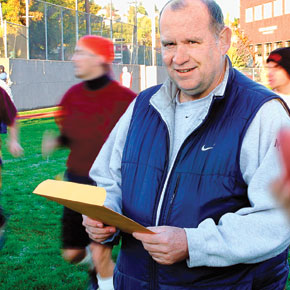Friendly Competition
Kellogg Has Built SPU’s Intramural Program Into
One of the Nation’s Largest YOU MIGHT GUESS
that Falcon athletes constitute only a small minority of Seattle
Pacific University students. And you’d be simultaneously right and
wrong. One hundred and seventy-two athletes play varsity sports
at SPU. That’s roughly 5 percent of the student body.
But many more students participate in intramural sports — an informal
but highly organized program that promotes friendly competition between
individuals, small teams or entire residence floors. Seattle Pacific’s
intramural program is one of the largest among small private universities,
and student involvement hovers between 70 and 80 percent — one of
the highest rates in the nation.
Intramural and club sports are a longstanding tradition at SPU, going
back almost to day one. The program’s enormous success, however, is
a more recent phenomenon.
“When I came in 1977, there weren’t many activities,” recalls Director
of Intramural and Club Sports Howie Kellogg. “Just basketball, softball
and football, and there were only five events in the entire Autumn
Quarter. There was even talk of taking the program away from the
Athletic Department.” But by offering more activities, Kellogg was
able to raise interest and involvement almost immediately. Aside
from the three years he spent in graduate school at the University
of Minnesota, he’s been at SPU ever since.
“Howie is one of the most underrated people at SPU,” says Jared
Skeith ’98, who worked with Kellogg for three years as student commissioner
of officials. “He has such a positive effect on hundreds of students.
And he’s so dedicated. There were times I had to kick him out of
the gym: ‘Howie, go home, I’ll take care of this.’”
Students are drawn to intramurals for a variety of reasons. Some
played football or baseball in high school — sports that aren’t
part of SPU’s varsity program. Some, like Cyrena “CyCy” Bell ’02,
participated in intramurals to “release energy, have fun, and relieve
some of the pressure that builds up when you’re studying.”
Intramurals may be fun, but Kellogg takes his job seriously. His
program operates as a fully functioning league, replete with tournaments,
rankings, officials and gift certificates as prizes. Teams and players
register through a Web site that also displays scores, schedules
and standings. There are at least 35 sports, with multiple activities
nearly every week. And to raise funds, he also opens Seattle Pacific
facilities to church leagues and alumni teams: “I have softball
teams who graduated a long time ago that still play together in
the summer. For some of them, it’s the only time they see each other.”
Along with the usual activities, like basketball, softball, volleyball
and football, Kellogg offers some more obscure choices: badminton,
bowling, chess, floor hocke y and pickleball (which drew record
64 teams last year). In fact, one obscure sport led to the SPU intramural
program’s own 15 minutes of fame. The year was 1986, and the sport
was Lazer Tag, a sort of high-tech paintball game. The Seattle Pacific
team won second place in a nationwide tournament, garnering international
media coverage — which, Kellogg chuckles, was the envy of his colleagues
in the varsity sports programs. The team’s $4,000 prize went back
into the intramural budget: Kellogg used it to buy floor hockey
equipment.
Never complacent, Kellogg constantly tries new approaches. One major
change came about 10 years back, when he noticed that attitude problems
were getting out of hand among some players. After comparing notes,
Kellogg and other intramural directors devised a 10-point sportsmanship
rating system. Now officials grade teams on their behavior during
games, and teams have to maintain a rating of 7.0 to participate
in tournaments. “We had a floor hockey team one time that was undefeated
but didn’t make the playoffs,” he says.
Aside from physical fitness benefits and practical lessons in teamwork
and sportsmanship, Kellogg says his program helps SPU retain students,
because those who are involved and enjoying themselves are more
likely to stay. Finally, he adds, intramurals break down social
barriers and help students build friendships: “It doesn’t matter
if they walk away winning or losing; they walk away together.”
— BY MARTIN STILLION
— PHOTO BY JOHN KEATLEY
Back to the top
Back to Athletics |
 |



From the President
The purpose of the Campaign for Seattle Pacific is bigger than ourselves.
"We are really investing in a venture of change and hope,"
says President Philip Eaton.
SPU Musicians Play Benaroya
For the third Christmas season in a row, SPU takes "The Sacred
Sounds of Christmas" downtown, performing in Benaroya Hall.
[Campus]
Meet the Alumni Board President
It took 30 years for the alumni board president, Darlene Hartley,
to rediscover her alma mater, reconnect with fellow alums —
and get a very warm welcome. [Alumni]
Reconciliation in South
Africa
Professor of English Susan Gallagher spotlights truth and reconciliation
in South Africa in her new book, as the African nation moves beyond
apartheid. [Faculty]
My Response
Gary Ames, who funded the $1 million Ames Initiative on Diversity
at SPU with his wife, talks about the power gained through diversity.
[My Response] |
 |



